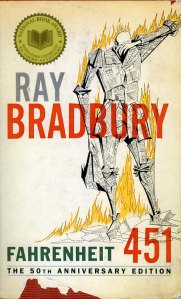Fahrenheit 451: The dystopian future that’s become our present
Bradbury, Ray. Fahrenheit 451. 165 p. New York: Ballantine Books. 1953.
Guy Montag is a third-generation fireman in a world where firemen are fire starters. An alarm gets raised, and Guy races to the reported site and burns every book on the premises. Book ownership has been outlawed. Literature, with its challenging concepts and provocative issues, is a menace to society.
Guy has become a man on autopilot, no longer thinking, feeling, or loving. He is ripe for an identity crisis, and a crisis of conscience. When Clarisse McClellan encounters Guy, he is shaken by this seventeen year old who still takes walks, picks daisies, and studies the stars. She starts conversations, and reveals that firemen of the past put out fires.
Clarisse represents the opposite mentality of Guy’s wife, Mildred, and humankind in general. Mildred avoids reality, and focuses on the characters on the projection screens in her parlor. She has minimal interest in her husband beyond his ability to earn money for more screens.
In Fahrenheit 451, Ray Bradbury depicts a society that is violent, fast-paced, technologically dependent, and removed from nature. He imagines a not-too-distant-time when the world will be populated by millions of detached Mildreds, wasting their lives watching characters blather and fight on large flat screens. I’m sad to say, I know plenty of adults that fit this image.
Clarisse’s death in a hit and run collision, and Mildred’s callousness toward the event, nudge Guy into action He decides to break the law, to save and read books. Guy ends up betrayed by his wife, and becomes the subject of a manhunt. Faber, a former English professor, helps Guy escape, and directs him toward an underground group of intellectuals that hope to plant seeds of knowledge in a future generation.
Bradbury utilizes his massive artillery of what my students call, “look-it-up-words.” He liberally pens sensuous similes and metaphors, and references historic events, literature, the Bible, and mythology. His characters give grand speeches and lectures. Fahrenheit 451’s themes run deep: censorship, civil rights, abandonment of nature, overdependence on technology, and the cultivation of violence and warfare.
As a librarian and life-long learner, no book has called to me the way Fahrenheit 451cries out. Its sense of urgency about keeping books in people’s hands, and maintaining freedom of information are a trumpet call to action. The crazy irony of the novel being banned only serves to underscore Bradbury’s message to readers and educators. Never take the right to read and think for granted! Beware of those who would erode your right to access information!
Given its themes, and Bradbury’s challenging text, Fahrenheit 451 is a complex reading experience. Scholastic suggests that the book has an interest level of grades 9-12, a reading level equivalent of 10.0, and a Lexile measure of 890 L. These assessments accurately reflect the challenge of the material and concepts in the novel. High school language arts students will benefit from Bradbury’s talent with figurative language and word choice. Government classes might study the text for its civil rights and anti-censorship themes.
Awards for Fahrenheit 451: National Endowment for the Arts Big Read Selection
Related Books by Ray Bradbury: The Illustrated Man, The Martian Chronicles
Links to Supporting Digital Content:
John Green discusses the first part of Fahrenheit 451: https://www.youtube.com/watch?v=kjCk8J6L_SI
Banned Books Week: In Defense of Fahrenheit 451: http://emertainmentmonthly.com/2014/09/27/banned-books-week-defense-fahrenheit-451/
A discussion with Ray Bradbury: https://www.youtube.com/watch?v=FL_y6gtxLvQ
- Posted in: Dystopian Fiction ♦ Pleasure Reading ♦ Science Fiction ♦ YA Fiction
- Tagged: activism, banned book, book burning, censorship, character, civil rights, courage, ethics, heroism, Hue Latimer, identity, Nicholas Ridley
